
Tom Whitney, Hovey/Kelley Work on Mouse. Memo from Tom White to Jerry Manock and Tom Hong, 14 May 1980, regarding Hovey-Kelley's continued involvement in the design of the Lisa mouse, and their interest in possibly manufacturing the mouse.
Bill Dresselhaus, Lisa Mouse Package Design. Memo from Bill Dresselhaus to Lisa mouse designers, 30 May 1980, outlining the division of labor and responsibility for the package design of the Lisa mouse.
Dean Hovey, Hovey-Kelley and the Mouse. Memo from Dean Hovey to Tom Whitney, 4 June 1980. "This memo's intent is to establish H/K's perception, to this date, of its involvement with Apple's Mouse development program." Explains how Hovey-Kelley became involved in the mouse project; why they decided to work on the project; and what they hope to get out of it.
Dean Hovey, Hovey-Kelley Mouse Billing. Memo from Dean Hovey to Bill Lapson, 4 August 1980, outlining the phases of Hovey-Kelley's work on the mouse, and progress toward completion.
Rickson Sun, Testing the Mouse. Memo from Rickson Sun to Bill Lapson, 16 October 1980, describing Hovey-Kelley's tests of the mouse.
Jim Yurchenco, Choosing Molding Vendor. Letter from Jim Yurchenco to Bill Lapson, 5 December 1980, recommending "Micro Molding for producing the mouse ribcage and detector block tooling ." The tools would be used to manufacture the mice, so it was critical to work with a company that could do precise work.
Dave Evans, Mouse Cable and Connector. Memo dated c. 20 January 1981, explaining the state of work on the connector cable for the Apple mouse.
Dave Evans, Mouse Report, December 1980. Mouse Project Team Report for December 1980 and January 1981, dated 2 February 1981.
Dave Evans, Mouse Connector. Memo dated 6 March 1981, describing recent agreements regarding the mouse connector.
Dave Evans, P3 Mouse Deliveries. Memo dated 17 March 1981, announcing the delivery of P3 mice. Includes a distribution list, and announcement of a meeting between Apple developers and mouse designers.
Dave Evans, Completion of 50 P3 Mice. Memo dated 23 March 1981, announcing the shipment of 50 P3 mice. Includes acknowledgement of the work of various members of the mouse development team at Apple and Hovey-Kelley.
Bill Lapson, Mouse Parts. Memo dated 10 April 1981, regarding "materials, colors, and textures for the case and keybutton, logo, and centering of the keybutton. "
Bill Lapson, Apple Mouse Droppings. Memo by Bill Lapson, dated 4 August 1981, summarizing the state of work on the mouse. Includes a list of people involved in the project, and their responsibilities.
Dave Evans, Mouse OEM Vendors (Whetstone). Memo dated 4 March 1982, describing presentation of a mouse designed by Whestone to Apple personnel.
Bill Lapson, Lore of the Mouse. Retrospective essay written 8 July 1982, and distributed to members of the mouse development group. "The Mouse project has matured to the point where many others will be involved in its evolution. This collection of facts should ensure that some of the important lore about the Mouse is neither lost or distorted as time goes on."
Release 1.0 includes interviews with Apple mouse designers Dean Hovey, Jim Sachs, Jim Yurchenco, and Rickson Sun, and Jef Raskin. Additional interviews with Larry Tesler have been conducted, but are not yet ready for publications; others are in development.
Dean Hovey, Interview with Dean Hovey. Interview with Dean Hovey, 22 June 2000 . Hovey was one of the co-founders of Hovey-Kelley Design, the firm that did much of the design work on the Lisa and Macintosh mice. In the interview Hovey discusses his contributions to the mouse project, the earlier work of mouse designers at Xerox PARC, working with Apple, and the influence of the Stanford Design Program.
David Kelley, Interview with David Kelley. Interview with David Kelley, 24 July 2000. Kelley was co-founder of Hovey-Kelley Design, and has overseen its growth since 1978. In this interview, he talks about his work as an engineer and product designer; relationship with Stanford; founding Hovey-Kelley; work on the Apple mouse; and the impact of the mouse project on Hovey-Kelley.
Jef Raskin, Jef Raskin on the One-Button Mouse. Jef Raskin describes his research on mouse design, and his advocacy of a one-button mouse, rather than a two- or three-button mouse (like the ones used in Douglas Engelbart's Augmentation Research Center, and Xerox PARC). Transcribed from an interview with Jef Raskin, 13 April 2000.
Jef Raskin, Jef Raskin on the Mac Graphical User Interface. Jef Raskin discusses the Macintosh's graphical user interface, and the importance of graphics in the machine more generally. He also briefly discusses his views on input devices, and preference for trackballs and tablets. Transcribed from an interview with Jef Raskin, 13 April 2000.
Jim Sachs, Interview with Jim Sachs. Interview with Jim Sachs, 29 March 2000. Sachs was one of the founding members of Hovey-Kelley, the firm that designed the Apple mouse. In this interview, Sachs discusses his background and education; the influence of the Stanford Design Program on the development of the mouse; the various engineering challenges the group faced in "moving the mouse from the laboratory to the living room;" ergonomics and user testing; and the "Zen" of product design.
Jim Yurchenco and Rickson Sun, Interview with Jim Yurchenco and Rickson Sun. Interview with Jim Yurchenco and Rickson Sun, 26 April 2000. Yurchenco and Sun worked on the Apple mouse project with Jim Sachs, Douglas Dayton, Dean Hovey, and David Kell. Sun contributed to the electrical design, while Yurchenco was responsible for the design of the interior structure that held the ball, optical sensors, and electronics-- what later came to be called the "ribcage." This interview covers their training at Stanford; work on the mouse; relations and other work with Apple Computer and Steve Jobs; the challenges of working with startups and other clients; and other subjects.
Release 1.0 includes 70 images relating to the development of the Apple mouse. For the sake of convenience, these are divided here into four categories: drawings, photographs or slides, handwritten notes, and advertisements.

Douglas Dayton, Drawing of Lisa mouse. Drawing of Lisa mouse by Douglas Dayton, drawn approximately August 1980 (dating in e-mail from Dayton to Alex Pang, 5 May 2000). The drawing shows the mouse from the top and the side. This version of the mouse features a ball much larger than the final version, and a button design based on the Appleshift key on the Lisa keyboard.

Douglas Dayton, Feedback on mouse design. Handwritten notes with feedback on Lisa mouse prototypes, dated 6 August 1980. Several versions of the mouse were shown to beta testers, and their impressions were recorded on several pages of notes. The drawings of different mice indicate that these tests focused on different shapes, textures, and button positioning; all the drawings are of two-button mice. The upper left-hand has a date of 6 Aug 80, and two sets of initials: DCD (Douglas Dayton) and KSC (Ken Campbell). (Identified in e-mail from Dayton to Alex Pang, 15 May 2000.)

Douglas Dayton, Sketches of mice. Back page of handwritten notes, dated 6 August 1980, by Douglas Dayton recording feedback on Lisa mouse prototypes with several rough sketches of mice. These show designs in which three fingers would rest on separate parts of the mouse, with buttons under the middle and ring fingers. (Identified in e-mail from Dayton to Alex Pang, 15 May 2000.)

Douglas Dayton, Sketch of mouse and mouse buttons. Sketches of Lisa mouse design by Douglas Dayton, drawn approximately August 1980 (dating in e-mail from Dayton to Alex Pang, 5 May 2000). There are seven drawings, featuring mice with different shapes, bevels, and edges; there are also two button designs, one solid and flat, the other with a raised corner. The latter resembles the Appleshift key on the Lisa keyboard.

Douglas Dayton, Sketch of mouse and mouse buttons. Sketches of Lisa mouse design by Douglas Dayton, drawn approximately August 1980 (dating in e-mail from Dayton to Alex Pang, 5 May 2000). There are four drawings; three of mice with flat or two-level button designs, and a fourth drawing of a two-level button (similar to the Appleshift key on the Lisa keyboard).

Douglas Dayton, Sketch of mouse and mouse buttons. Sketches of Lisa mouse design by Douglas Dayton, drawn approximately August 1980 (dating in e-mail from Dayton to Alex Pang, 5 May 2000). There are ten drawings; in most of them are Dayton is experimenting with different mouse body shapes. In three drawings, Dayton is also experimenting with the placement of the button (or buttons), and angle at which the users hand rests.
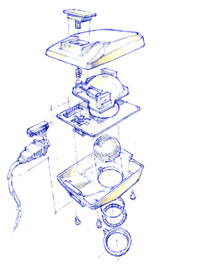
Douglas Dayton, Exploded diagram of the Apple mouse. Exploded diagram of the mouse, color drawing by Douglas Dayton. (undated)

Douglas Dayton, Exploded diagram of the Apple mouse with titles. Exploded diagram of the mouse, a black-and-white copy of the color drawing by Douglas Dayton with parts titled. (undated)

Douglas Dayton, Hand and mouse. Hand with mouse. The underside of the mouse is visible, and the locking ring and ball have been removed. The drawing shows how easy the mouse would be to clean. Color drawing by Douglas Dayton. (undated)

Douglas Dayton, Mouse encoder and ball container. View of the mouse encoders housing, shafts, poron rollers, and detector mount. Color drawing by Douglas Dayton. (undated)

Douglas Dayton, Ribcage drawing. Undated sketch by Douglas Dayton of the mouse "ribcage." This is a simplified drawing showing the rollers and optical encoders that were used to record the motion of the mouse's ball.
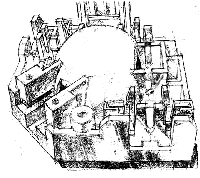
Douglas Dayton, Ribcage drawing. Undated sketch by Douglas Dayton of the mouse "ribcage." This drawing shows how the ribcage holds the rollers and optical encoders.

Unknown, Sketch of mice. Four drawings of mice casings, dated 30 May 1980. The larger two drawings are of a three-button mouse, with a negative angle (pointing the users hand downward) and ball moved the the top of the mouse, under the users fingers.

Unknown, Patent figure 2. Drawing of "a perspective of the present invention illustrating the cursor control device as it appears without the housing cover." Used as an illustration in the two patent applications (4,464,652, dated 7 August 1984; and RE32,633, dated 29 March 1988) Apple filed covering work on the mouse.

Unknown, Patent figure 3. Drawing of "a perspective view of the unitary frame of the present invention coupled to the printed circuit board base, illustrating the placement of photo-detectors and the coupling connector." Used as an illustration in the two patent applications (4,464,652, dated 7 August 1984; and RE32,633, dated 29 March 1988) Apple filed covering work on the mouse.

Unknown, Patent figure 4. Drawing of "a further perspective view of the unitary frame and circuit board of FIG. 3 illustrating the position of a roller shaft and encoder wheel.." Used as an illustration in the two patent applications (4,464,652, dated 7 August 1984; and RE32,633, dated 29 March 1988) Apple filed covering work on the mouse.

Unknown, Patent figure 5. Drawing of "a perspective of the present invention illustrating the cursor control device as it appears without the housing cover." Used as an illustration in the two patent applications (4,464,652, dated 7 August 1984; and RE32,633, dated 29 March 1988) Apple filed covering work on the mouse.

Unknown, Patent figures 8-9. Two drawings used as illustration in the two patent applications (4,464,652, dated 7 August 1984; and RE32,633, dated 29 March 1988) Apple filed covering work on the mouse. Figure 8 shows "a perspective view of the coupling of the unitary frame cage and printed circuit board combination to the housing base of the present invention;" Figure 9 is "a perspective view illustrating the placement of the control switch within the housing base."

Unknown, Patent figure 10. Drawing of a "perspective view of the final assembly of the present invention illustrating the coupling of the cover and base portions of the housing." Used as an illustration in the two patent applications (4,464,652, dated 7 August 1984; and RE32,633, dated 29 March 1988) Apple filed covering work on the mouse.

Unknown, Patent figure 12. Drawing of "a diagrammatical illustration of the alignment of the photo-emitters in relation to each encoder disc." Used as an illustration in the two patent applications (4,464,652, dated 7 August 1984; and RE32,633, dated 29 March 1988) Apple filed covering work on the mouse.

Douglas Dayton, Field of Apple mouse prototypes. Photograph of 27 prototype mouse covers, showing different ergonomic approaches, shapes, and arrangements of buttons. (undated, c. 1980)

Douglas Dayton, Mouse prototypes. Photograph of 27 prototype mouse covers, showing different ergonomic approaches, shapes, and arrangements of buttons. The prototypes include a mix of one- and two-button designs, as well as a few with no buttons at all (included to test the shape of the mouse body). (undated, c. 1980)

Douglas Dayton, Mouse prototypes close up. Closeup of mice shown in dayton6.jpg, showing a number of mice carved from wood. (undated, c. 1980)

Douglas Dayton, Three one-button mice prototypes. Three one-button mice prototypes, with the buttons in different positions. (undated, c. 1980)

Douglas Dayton, Race-car view of early Hovey-Kelley prototype. Profile view of the first Hovey-Kelley mouse prototype, demonstrating the essential features of the mechanical and electrical design, but without buttons. (undated, c. 1980)

Douglas Dayton, Top view of early Hovey-Kelley prototype. Top view of the first Hovey-Kelley mouse prototype, demonstrating the essential features of the mechanical and electrical design, but without buttons. (Similar to image hoveys11.jpg) (undated, c. 1980)

Douglas Dayton, Closeup of early Hovey-Kelley prototype. Closeup of the front of an Hovey-Kelley mouse prototype, demonstrating the essential features of the mechanical and electrical design, but without buttons. (undated, c. 1980)

Douglas Dayton, Lisa mouse cover, side view. Lisa mouse cover, side view. (undated, c. 1980)

Douglas Dayton, Lisa mouse cover, top view. Lisa mouse cover, top view. (undated, c. 1980)

Douglas Dayton, Mold for Lisa mouse cover. Mold for Lisa mouse cover. (undated, c. 1980)

Douglas Dayton, Mold for two-button "golf ball" prototype mouse. Mold for two-button "golf ball" prototype mouse. This mouse had a number of dimples on the area where the user's hand rested. (undated, c. 1980)

Douglas Dayton, Mold for Lisa mouse cover, top view. Mold for Lisa mouse cover, top view. (undated, c. 1980)

Douglas Dayton, Mold for Lisa mouse cover, closeup. Mold for Lisa mouse cover, closeup. (undated, c. 1980)

Douglas Dayton, Lisa and "golf ball" molds. Lisa and "golf ball" molds. (undated, c. 1980)
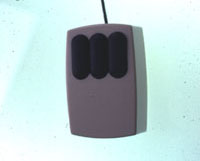
Dean Hovey, Xerox PARC mouse (top view). Top view of Xerox PARC mouse. Slide taken by Dean Hovey during Apple mouse development, c. 1980.

Dean Hovey, Interior of Xerox PARC mouse. View of Xerox PARC mouse with top cover removed. Slide taken by Dean Hovey during Apple mouse development, c. 1980.

Dean Hovey, Underside of Xerox PARC mouse. Underside of Xerox PARC mouse. Slide taken by Dean Hovey during Apple mouse development, c. 1980.

Dean Hovey, Interior of Xerox PARC mouse. View of Xerox PARC mouse with top cover and ball removed. Slide taken by Dean Hovey during Apple mouse development, c. 1980.

Dean Hovey, Underside, buttons, and cover of Xerox PARC mouse. Disassembled Xerox PARC mouse, showing its underside, buttons, and cover. Note that the mouse has two ball bearings at the top; the ball from which position readings were taken also functioned as a ball bearing. Slide taken by Dean Hovey during Apple mouse development, c. 1980.

Dean Hovey, Xerox PARC mouse (top view). Top view of Xerox PARC mouse. Slide taken by Dean Hovey during Apple mouse development, c. 1980.
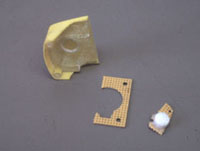
Dean Hovey, Dean Hovey's butter dish prototype. The first quick mouse prototype made by Dean Hovey, the weekend after talking with Steve Jobs about Hovey-Kelley designing the Apple mouse. The prototype is made from a plastic butter dish and roll-on ball from a bottle of deodorant. Slide taken by Dean Hovey during Apple mouse development, c. 1980.

Dean Hovey, Three one-button mouse mechanical prototype. Three one-button mechanical prototype, demonstrating the major mechanical concepts in the Apple mouse. The small plaque on the mouse reads "H-K 09." Slide taken by Dean Hovey during Apple mouse development, c. 1980.
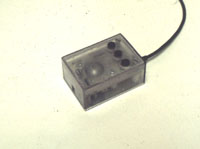
Dean Hovey, Three-button mouse prototype with clear cover. Three-button prototype with clear cover. Slide taken by Dean Hovey during Apple mouse development, c. 1980.

Dean Hovey, Worktable with parts for three-button mouse prototype with clear cover. Worktable with parts for three-button mouse prototype with clear cover. Slide taken by Dean Hovey during Apple mouse development, c. 1980.

Dean Hovey, Top view of parts for three-button mouse prototype with clear cover. Top view of parts for three-button mouse prototype with clear cover. Slide taken by Dean Hovey during Apple mouse development, c. 1980.

Dean Hovey, Optical encoders and circuit board for mouse prototype. Optical encoders and printed circuit board for mouse prototype. The letters on the upper left spell out "HK rev 0.2." Slide taken by Dean Hovey during Apple mouse development, c. 1980.

Dean Hovey, Top view of clear mouse prototype without buttons or cord. Top view of clear mouse prototype, showing the ribcage, ball and optical encoders. Slide taken by Dean Hovey during Apple mouse development, c. 1980.

Dean Hovey, Side view of clear mouse prototype without buttons, with top cover removed. Side view of clear mouse prototype without buttons, with top cover removed to reveal the ribcage, ball, and optical encoders. Slide taken by Dean Hovey during Apple mouse development, c. 1980.

Dean Hovey, Top view of clear mouse prototype without buttons, with cord attached. Top view of clear mouse prototype without buttons, with cord attached. Slide taken by Dean Hovey during Apple mouse development, c. 1980.

Dean Hovey, Shelf of mice prototypes. Shelf of mice prototypes. Slide taken by Dean Hovey during Apple mouse development, c. 1980.

Dean Hovey, Bottom of clear mouse prototype. Bottom of clear mouse prototype, showing space for retainer ring. Slide taken by Dean Hovey during Apple mouse development, c. 1980.

Dean Hovey, Top view of early Hovey-Kelley prototype without buttons. Top view of early Hovey-Kelley prototype without buttons. (Similar to image dayton10.jpg) Slide taken by Dean Hovey during Apple mouse development, c. 1980."

Bill Dresselhaus (?), Note of meeting re: mouse design, 15 August 1980. 1-page handwritten note of meeting re: mouse design, 15 August 1980. The note includes mention of ideas about mouse aesthetics, with a focus on the shape of the casing, its form, and the button. At this point, the idea of having the button emulate either the logo nameplate mount or disk slot detail in the Lisa is being discussed. The name Bill Dresselhaus is on the upper right.
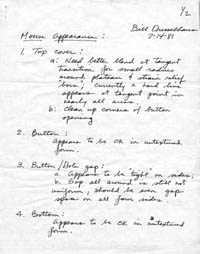
Bill Dresselhaus (?), Notes re: Mouse Appearance. Notes from a meeting re: Mouse appearance. The name Bill Dresselhaus appears on the upper right, as well as a date. The notes discuss several element s of the mouse, including the pop cover, button, button/hole gap, and bottom.This page was stapled to an undated agenda for a meeting about the design of the mouse.

Chris Espinosa, Chris Espinosa Macintosh brainstorms, p. 1. First of two pages of handwritten notes by Chris Espinosa's handwritten notes on "People's Computer: Software." The page's heading reads "Most important functions: Entry, Retrieval, Manipulation of Data." He recalls (in e-mail to Alex Pang, 21 June 2000) that "I believe I wrote that, probably in the summer or fall of 1981, early in the development of the Macintosh. Not for anything official, but as part of the overall blue-sky thinking that we were being encouraged to do about what the Mac could be." (undated)

Chris Espinosa, Chris Espinosa Macintosh brainstorms, p. 2. Second of two pages of handwritten notes by Chris Espinosa's handwritten notes on "People's Computer: Software." The page's categories include "Application: Personal Computing, Information Retrieval, Education, Real World." He recalls (in e-mail to Alex Pang, 21 June 2000) that "I believe I wrote that, probably in the summer or fall of 1981, early in the development of the Macintosh. Not for anything official, but as part of the overall blue-sky thinking that we were being encouraged to do about what the Mac could be." (undated)

Dean Hovey, Hovey-Kelley mouse brainstorming session, p. 1. Paper (original is 14 x 17 inches) from early Hovey-Kelley mouse brainstorming session. The undated page records ideas tossed out during an early mouse design session. It indicates that the group also thought about other input devices, like light pens.This page was folded with brain1-2.jpg, suggesting they were from the same session. (undated)

Dean Hovey, Hovey-Kelley mouse brainstorming session, p. 2. Paper (original is 14 x 17 inches) from the early Hovey-Kelley mouse brainstorming session. The undated page records ideas tossed out during an early mouse design session. This page includes ideas about how to read the motion off the mouse ball. This page was folded with brain1-1.jpg, suggesting they were from the same session. (undated)

Dean Hovey, Hovey-Kelley mouse brainstorming session, p. 3. Paper (original is 14 x 17 inches) from early Hovey-Kelley mouse brainstorming session. The undated page records ideas tossed out during an early mouse design session, and includes notes on "problems with the mouse." This page was folded with brain2-2.jpg and brain2-3.jpg, suggesting they were from the same session. (undated)

Dean Hovey, Hovey-Kelley mouse brainstorming session, p. 4. Paper (original is 14 x 17 inches) from early Hovey-Kelley mouse brainstorming session. The undated page records ideas tossed out during an early mouse design session. It indicates that the group also thought about other input devices, like trackballs. This page was folded with brain2-1.jpg and brain2-3.jpg, suggesting they were from the same session. (undated)

Dean Hovey, Hovey-Kelley mouse brainstorming session, p. 5. Paper (original is 14 x 17 inches) from early Hovey-Kelley mouse brainstorming session. The undated page records ideas tossed out during an early mouse design session. This page includes a drawing of a ball with optical encoders, and a cross-section of a ball being held at its equator-- two critical ideas that guided Hovey-Kelley's subsequent work. This page was folded with brain2-1.jpg and brain2-2.jpg, suggesting they were from the same session. (undated)

Unknown, Sketch and notes re: mouse and mouse buttons. Undated drawing and note re: mouse and mouse buttons. The text reads:1. Try wedge shape on side a la keyboard.2. Try mimic of keyboard Appleshift key.3. Try match keyboard angle -13 degrees.4. Try 3 degree rake on back to match keyboard.5. Try 1.0 and 1.5 plateau height.

Unknown, Feedback on mouse design. Handwritten notes with feedback on Lisa mouse prototypes, dated 6 August 1980. It appears that several versions of the mouse were shown to beta testers, and their impressions recorded on notes like these. In this case, a user found the square designs too boxy, small ones feel like not enough, likes the texture bars-- enhances control, buttons far apart helps-- feels would promote fewer errors, likes softer material. They are also testing one-button versus two-button designs, and a one-button design with a button on the side rather than top of the mouse (which users would click with their thumb).

Unknown, Agenda of Mouse Meeting, n.d.. Handwritten agenda for a Mouse meeting, undated. Topics of discussion include:1. Review of drawing status 2. Additional drawings or specs 3. Eliminating pots 4. Assembly and test sequence 5. Repair 6. Detector and LED interchangeability. At the bottom of the page is a list of participants: Dean Hovey, Jim Sachs, Jim Yurchenco, Bill Lapson, Bill Bull, Ken Lim, Dave Jones.

Unknown, Notes re: noise issue. Handwritten notes re: noise issue. The version of the mouse being tested at this point apparently was rather noisy, and these notes discuss the pros and cons of covering it in felt, using a felt or polypropylene felt pad, and Jim Sachs view that the ball was responsible for most of the noise. This last point suggests that this mouse model used an uncoated, stainless steel ball.

Unknown, Lisa mouse project schedule. Handwritten copy of Lisa mouse project schedule, attached to the "Mouse Project Team Report December 1980 and January 1981."

Unknown, Mouse production and development schedule. Handwritten copy of mouse production and development schedule, attached to the "Mouse Project Team Report December 1980 and January 1981." It shows various tasks, dependencies, and deadlines.

Unknown, "At last the mouse is here en masse!" (advertisement). Advertisement for the Hawley X063X mouse, manufactured by Jack S. Hawley's Mouse House. (undated)
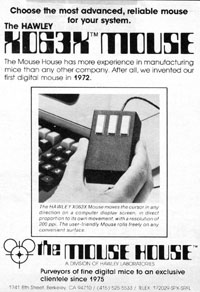
Unknown, "The Hawley X063Mouse is here!" (advertisement). Advertisement for the Hawley X063X mouse, manufactured by Jack S. Hawley's Mouse House, "purveyor of fine digital mice to an exclusive clientele since 1975." (undated)

Unknown, Mouse House logo. Logo for Jack S. Hawley's Mouse House.